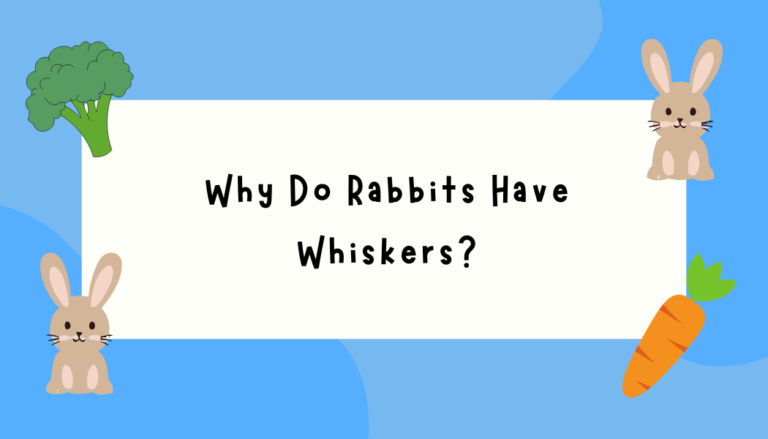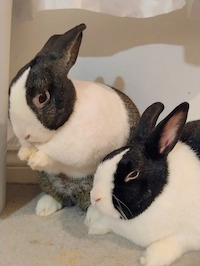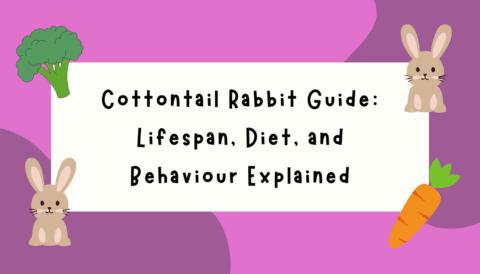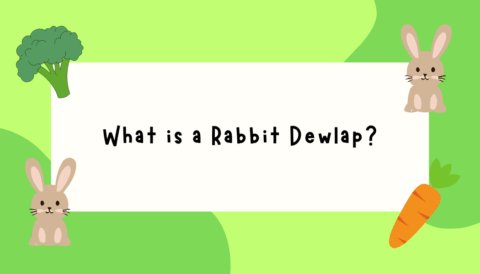Table of Contents
Rabbits are known for their adorable features – floppy ears, twitchy noses, and, of course, their long, delicate whiskers. While whiskers add to their charm, they serve a far more important purpose. Along with their exceptional sense of hearing and smell, rabbit whiskers are part of their sophisticated sensory system that helps them navigate and detect danger in their environment.
Rabbit whiskers, scientifically known as vibrissae, are extremely sensitive hairs connected to nerve endings in the skin. According to a study by Doe (2022)1, these whiskers can detect subtle shifts in air currents and vibrations, helping rabbits navigate and stay alert to potential dangers. This sensitivity is particularly useful in environments where rabbits’ vision is limited, like at dusk or in dark burrows.
How Do Rabbits Use Their Whiskers To Explore?
Have you noticed how your bunny uses its whiskers to explore new areas?
Rabbits rely on their whiskers to sense their surroundings, especially in darker areas or when exploring tight spaces. Providing toys like these fun interactive edible balls encourage them to use their natural instincts while staying mentally and physically active.
To ensure your rabbit has a safe environment, consider providing them with a whisker-friendly setup, such as low-edge feeding bowls.
These clever whiskers act as little sensors, picking up on subtle changes in the air and feeling tiny vibrations, and combined with other senses like their sharp hearing and strong sense of smell, allow rabbits to navigate safely, discover delicious hidden treats, and avoid unexpected obstacles. An edible tunnel is perfect for encouraging their exploratory behaviour whilst keeping them entertained.
Unlike humans, rabbits have monocular vision, meaning they can see things on either side of their body but have a blind spot right in front of their nose (Smith, 2018)2 . This is where their whiskers come to the rescue!
By brushing their whiskers against objects, they can “feel” what lies ahead, making it much easier to explore without bumping into anything. Whether your bunny is hopping around the corners of your living room or venturing into the great outdoors, these sensitive whiskers keep them safe and sound.
At night or in dark spaces like rabbit burrows, where visibility is limited, whiskers become even more critical. Since rabbits are crepuscular – meaning they’re most active at dawn and dusk – these features assist them in navigating their surroundings.
Can Rabbit Whiskers Help Them Measure Space?
Rabbit whiskers play a crucial role in helping bunnies measure spaces. They allow rabbits to assess openings and pathways to avoid getting stuck.
Have you noticed your rabbit pausing before exploring a new area? This cautious behaviour often involves their whiskers, which help gauge whether they can fit through.
Did you know that a rabbit’s whiskers are usually as wide as its body? When their whiskers brush against the sides of an opening, they signal whether the bunny can pass through safely, helping them avoid tight spots that could lead to injuries
How Do Whiskers Keep Rabbits Safe From Danger?
Whiskers are essential for rabbit safety, acting as a natural alarm system. They detect potential threats, allowing for swift reactions to danger – whether from predators or sharp objects nearby. These sensitive hairs send signals to a rabbit’s brain about nearby dangers, enabling quick escapes.
Their heightened sensitivity explains why rabbits react promptly to the slightest hint of danger. Ensuring they receive proper nutrition is equally vital for their overall well-being. High-quality Timothy Hay, such as the Small Pet Select 2nd Cutting Timothy Hay, provides essential fiber and nutrients to keep your rabbit healthy and active.
When Jet first encountered our outdoor rabbit pen, I noticed how his whiskers twitched every time he brushed against the sides of the enclosure. One afternoon, while lounging outside, Jet froze, his whiskers flicking rapidly. I didn’t see anything unusual at first, but a few moments later, I spotted a stray cat lurking nearby. Jet had sensed the potential danger well before his eyes or ears did, a clear reminder of just how sensitive and important his whiskers are.
Exploring The World Through Whiskers
Now that we’ve covered the basics, let’s delve into the fascinating ways rabbits use these incredible sensory tools every day!
Navigating in Low-Light Conditions
Although rabbits don’t have the best night vision, their whiskers are essential for navigating dark places – like their snug burrows or shadowy corners of your living room. These sensitive hairs detect nearby objects, enabling them to weave through tunnels or tall grass effortlessly. Their whiskers and acute sense of hearing allow them to detect movement and navigate confidently even in low light, compensating for their limited vision.
Feeling and Exploring
Curiosity is inherent in rabbits! When they encounter something new, they often use their whiskers to “feel out” unfamiliar objects. You might have noticed how your bunny nudges intriguing items with their whiskers first, ensuring they are safe before getting too close. This cautious approach allows them to satisfy their curiosity while staying out of harm’s way.
Communication and Interaction
Whiskers also play a key role in how rabbits interact with one another. These sensory tools help them detect nearby rabbits and other animals, which is crucial, especially in the wild. Living in groups, rabbits rely on each other for protection and communication. Whether darting through a bustling burrow or meeting a new friend, those whiskers help them stay connected to their surroundings.
When I first brought Leo and Jet home, I watched them explore their new space with curiosity. Leo cautiously approached the corner of the room, his whiskers twitching as he brushed against the furniture, taking in the unfamiliar scents. Jet, on the other hand, zipped around, using his whiskers to navigate the maze of furniture.
Do All Rabbits Have The Same Type Of Whiskers?
Not all rabbits have the same kind of whiskers! Just as each breed varies in size, coat texture, and ear length, their whiskers come in various lengths, thicknesses, and placements. For instance, larger breeds may have long, thick whiskers that enhance their sensory abilities, while smaller breeds often have shorter, thinner whiskers suited to their unique lifestyles.
Regardless of breed, all rabbits share a common goal with their whiskers: navigating their world and spotting potential dangers.
Fun Facts About Rabbit Whiskers
Here are some interesting facts about rabbit whiskers. Let’s explore how these little sensory wonders play a huge role in a rabbit’s life!
- Directional Sensing: Have you noticed how rabbit whiskers grow in different patterns? Some extend forward while others fan out to the sides. This unique arrangement provides a broad range of sensitivity, helping adventurous bunnies feel their way through new territories!
- Whiskers All Around: While we often think of whiskers as being located on their noses, rabbits have whiskers around their eyes too! These additional whiskers act as protective barriers, shielding their eyes from dirt and unexpected objects that may come too close. It’s their way of staying safe while exploring!
- Forever Growing: Rabbit whiskers grow continuously throughout their lives! If one breaks or falls out, it usually grows back quickly. However, trimming a rabbit’s whiskers can leave them disoriented and anxious since they rely on these sensitive sensors to navigate their environment.
To learn more about the impact of trimming and how to care for your furry friend, check out our blog: What Happens if You Cut a Rabbit’s Whiskers? Why You Shouldn’t Trim Them + Essential Care Tips!
Conclusion
Rabbit whiskers are vital sensory tools that help them navigate their world and stay safe. To support their sensory abilities and general wellness, consider adding vitamins to their diet, such as this Pro-C Prebiotic & Probiotic Powder for Rabbits.
Recommended Products for Your Rabbit’s Health and Happiness:
- Interactive Rabbit Toys: Stimulate their whisker-driven navigation and play instincts
- Play Tunnels: Perfect for sensory enrichment and physical exercise
- Gentle Grooming Brushes: Keep their coat smooth and their whiskers unobstructed
- Premium Timothy Hay: Essential for a healthy diet and overall wellness
- Low-edge Feeding Bowl: Designed to prevent whisker fatigue while making mealtime comfortable for your rabbit
- Probiotic and Prebiotic Powder: Supports digestive health and strengthens your rabbit’s immune system.




